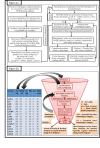Proteome scale comparative modeling for conserved drug and vaccine targets identification in Corynebacterium pseudotuberculosis
- PMID: 25573232
- PMCID: PMC4243142
- DOI: 10.1186/1471-2164-15-S7-S3
Proteome scale comparative modeling for conserved drug and vaccine targets identification in Corynebacterium pseudotuberculosis
Abstract
Corynebacterium pseudotuberculosis (Cp) is a pathogenic bacterium that causes caseous lymphadenitis (CLA), ulcerative lymphangitis, mastitis, and edematous to a broad spectrum of hosts, including ruminants, thereby threatening economic and dairy industries worldwide. Currently there is no effective drug or vaccine available against Cp. To identify new targets, we adopted a novel integrative strategy, which began with the prediction of the modelome (tridimensional protein structures for the proteome of an organism, generated through comparative modeling) for 15 previously sequenced C. pseudotuberculosis strains. This pan-modelomics approach identified a set of 331 conserved proteins having 95-100% intra-species sequence similarity. Next, we combined subtractive proteomics and modelomics to reveal a set of 10 Cp proteins, which may be essential for the bacteria. Of these, 4 proteins (tcsR, mtrA, nrdI, and ispH) were essential and non-host homologs (considering man, horse, cow and sheep as hosts) and satisfied all criteria of being putative targets. Additionally, we subjected these 4 proteins to virtual screening of a drug-like compound library. In all cases, molecules predicted to form favorable interactions and which showed high complementarity to the target were found among the top ranking compounds. The remaining 6 essential proteins (adk, gapA, glyA, fumC, gnd, and aspA) have homologs in the host proteomes. Their active site cavities were compared to the respective cavities in host proteins. We propose that some of these proteins can be selectively targeted using structure-based drug design approaches (SBDD). Our results facilitate the selection of C. pseudotuberculosis putative proteins for developing broad-spectrum novel drugs and vaccines. A few of the targets identified here have been validated in other microorganisms, suggesting that our modelome strategy is effective and can also be applicable to other pathogens.
Figures


Similar articles
-
An integrated structural proteomics approach along the druggable genome of Corynebacterium pseudotuberculosis species for putative druggable targets.BMC Genomics. 2015;16 Suppl 5(Suppl 5):S9. doi: 10.1186/1471-2164-16-S5-S9. Epub 2015 May 26. BMC Genomics. 2015. PMID: 26041381 Free PMC article.
-
A novel comparative genomics analysis for common drug and vaccine targets in Corynebacterium pseudotuberculosis and other CMN group of human pathogens.Chem Biol Drug Des. 2011 Jul;78(1):73-84. doi: 10.1111/j.1747-0285.2011.01118.x. Epub 2011 May 25. Chem Biol Drug Des. 2011. PMID: 21443692
-
Serological proteome analysis of Corynebacterium pseudotuberculosis isolated from different hosts reveals novel candidates for prophylactics to control caseous lymphadenitis.Vet Microbiol. 2014 Nov 7;174(1-2):255-60. doi: 10.1016/j.vetmic.2014.08.024. Epub 2014 Sep 6. Vet Microbiol. 2014. PMID: 25236983
-
Corynebacterium pseudotuberculosis: microbiology, biochemical properties, pathogenesis and molecular studies of virulence.Vet Res. 2006 Mar-Apr;37(2):201-18. doi: 10.1051/vetres:2005056. Vet Res. 2006. PMID: 16472520 Review.
-
Antigens of Corynebacterium pseudotuberculosis and prospects for vaccine development.Expert Rev Vaccines. 2009 Feb;8(2):205-13. doi: 10.1586/14760584.8.2.205. Expert Rev Vaccines. 2009. PMID: 19196200 Review.
Cited by
-
Essential genome of Campylobacter jejuni.BMC Genomics. 2017 Aug 14;18(1):616. doi: 10.1186/s12864-017-4032-8. BMC Genomics. 2017. PMID: 28806924 Free PMC article.
-
Proteomics of Toxigenic Corynebacteria.Proteomes. 2023 Dec 30;12(1):2. doi: 10.3390/proteomes12010002. Proteomes. 2023. PMID: 38250813 Free PMC article. Review.
-
An integrative in-silico approach for therapeutic target identification in the human pathogen Corynebacterium diphtheriae.PLoS One. 2017 Oct 19;12(10):e0186401. doi: 10.1371/journal.pone.0186401. eCollection 2017. PLoS One. 2017. PMID: 29049350 Free PMC article.
-
Novel Drug Targets for Food-Borne Pathogen Campylobacter jejuni: An Integrated Subtractive Genomics and Comparative Metabolic Pathway Study.OMICS. 2015 Jul;19(7):393-406. doi: 10.1089/omi.2015.0046. Epub 2015 Jun 10. OMICS. 2015. PMID: 26061459 Free PMC article.
-
Bridging drug discovery through hierarchical subtractive genomics against asd, trpG, and secY of pneumonia causing MDR Staphylococcus aureus.Mol Genet Genomics. 2024 Mar 13;299(1):34. doi: 10.1007/s00438-024-02115-8. Mol Genet Genomics. 2024. PMID: 38478130
References
-
- Dorella FA, Pacheco LG, Oliveira SC, Miyoshi A, Azevedo V. Corynebacterium pseudotuberculosis: microbiology, biochemical properties, pathogenesis and molecular studies of virulence. Veterinary research. 2006;37(2):201–218. - PubMed
-
- Soares SC, Trost E, Ramos RT, Carneiro AR, Santos AR, Pinto AC, Barbosa E, Aburjaile F, Ali A, Diniz CA, Genome sequence of Corynebacterium pseudotuberculosis biovar equi strain 258 and prediction of antigenic targets to improve biotechnological vaccine production. Journal of biotechnology. 2012. - PubMed
-
- Williamson LH. Caseous lymphadenitis in small ruminants. Vet Clin North Am Food Anim Pract. 2001;17(2):359–371. vii. - PubMed
Publication types
MeSH terms
Substances
LinkOut - more resources
Full Text Sources
Other Literature Sources
Medical
Miscellaneous

